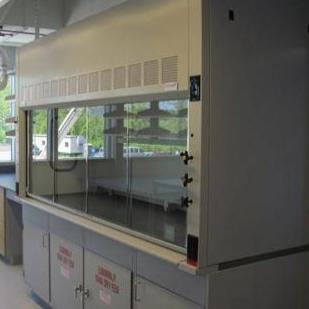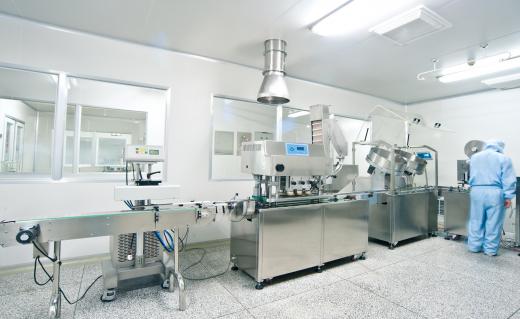Fume cupboards, often called fume hoods, are used to protect laboratory workers from hazardous chemicals. Air flow through a fume cupboard prevents toxic chemical fumes from wafting through the room. It is important to note that fume hoods may look similar to another laboratory safety device, the biosafety cabinet, but the two are not interchangeable — fume hoods should be used only for chemicals, and biosafety cabinets only for biohazardous materials.
The typical fume hood is a completely enclosed cupboard with a ventilation system. A sash at the front of the cupboard, usually made of glass, allows users to access the inside of the hood. Sashes may move horizontally or vertically, or in some cases in both directions. Some substances, such as radioactive materials and perchloric acid, require specialized fume hoods and should only be used in such a hood. Any chemicals and equipment inside a hood should be set at least 6 inches (about 15.25 cm) back from the opening for the user's protection.

A continuous stream of air flows through a fume cupboard, capturing hazardous fumes and venting them to the outside of the building. Once hazardous fumes are outside, their concentration in the outdoor air is so small that it does not pose any risk. The effectiveness of a fume hood depends on the velocity of the air flowing through it. Air velocity at the hood face — the point where the sash is raised to allow the user to access materials inside it — is routinely tested to ensure adequate performance.

The required air velocity for a fume cupboard depends on the toxicity of the materials being used inside. Common, less hazardous laboratory chemicals, such as ethanol, require only a class C cupboard with a face velocity of 75 to 95 feet per minute (fpm), or 23 to 29 meters per minute (mpm). More hazardous materials, such as most acids, require a class B cupboard with a face velocity of 95 to 110 fpm (29 to 33.5 mpm). Extremely toxic chemicals, including carcinogens, must be used in a class A cupboard with an average face velocity of 115 to 125 fpm (35 to 28 mpm). No point on the face of a class A cupboard may have a velocity lower than 100 fpm (30.5 mpm).
Standard fume hoods exhaust a constant volume of air, which causes the face velocity to increase as the hood is lowered. A bypass fume cupboard uses constant air volume (CAV) technology, which removes the same volume of air at all times, even when the sash is closed, but does not cause increasing face velocity as a standard hood does. Variable air volume (VAV) and auxiliary air hoods are designed to decrease energy consumption while maintaining the protective value of the fume cupboards. VAV hoods do this by reducing the exhaust volume when the sash is lowered, while auxiliary air hoods take in outside air as part of the exhaust.
